2017 Hyundai Elantra battery
[x] Cancel search: batteryPage 451 of 571
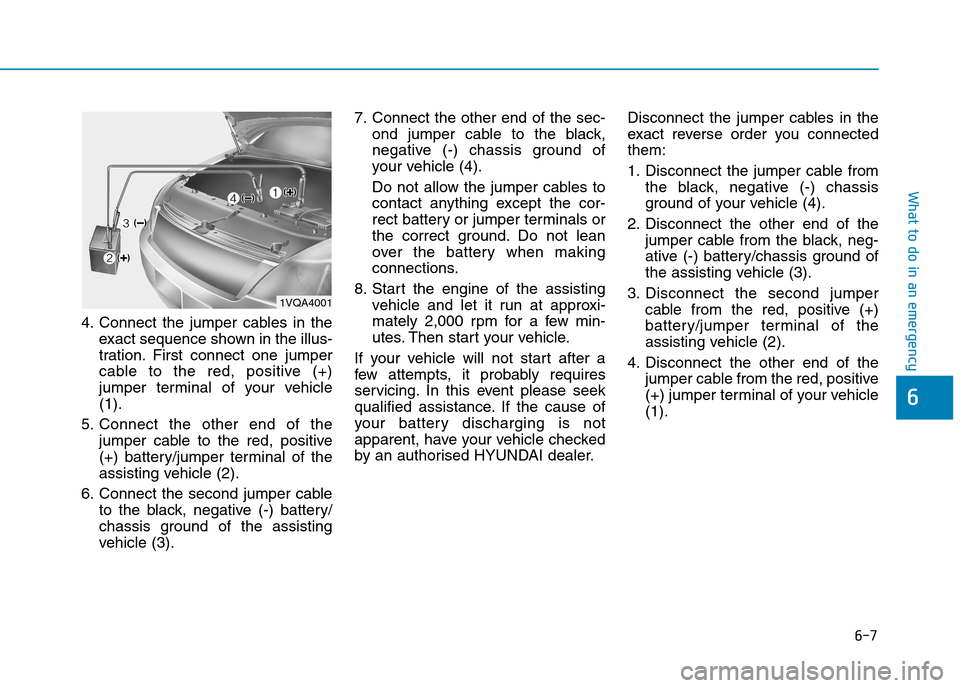
6-7
What to do in an emergency
4. Connect the jumper cables in the
exact sequence shown in the illus-
tration. First connect one jumper
cable to the red, positive (+)
jumper terminal of your vehicle
(1).
5. Connect the other end of the
jumper cable to the red, positive
(+) battery/jumper terminal of the
assisting vehicle (2).
6. Connect the second jumper cable
to the black, negative (-) battery/
chassis ground of the assisting
vehicle (3).
7. Connect the other end of the sec-
ond jumper cable to the black,
negative (-) chassis ground of
your vehicle (4).
Do not allow the jumper cables to
contact anything except the cor-
rect battery or jumper terminals or
the correct ground. Do not lean
over the battery when making
connections.
8. Start the engine of the assisting
vehicle and let it run at approxi-
mately 2,000 rpm for a few min-
utes. Then start your vehicle.
If your vehicle will not start after a
few attempts, it probably requires
servicing. In this event please seek
qualified assistance. If the cause of
your battery discharging is not
apparent, have your vehicle checked
by an authorised HYUNDAI dealer.
Disconnect the jumper cables in the
exact reverse order you connected
them:
1. Disconnect the jumper cable from
the black, negative (-) chassis
ground of your vehicle (4).
2. Disconnect the other end of the
jumper cable from the black, neg-
ative (-) battery/chassis ground of
the assisting vehicle (3).
3. Disconnect the second jumper
cable from the red, positive (+)
battery/jumper terminal of the
assisting vehicle (2).
4. Disconnect the other end of the
jumper cable from the red, positive
(+) jumper terminal of your vehicle
(1).6
1VQA4001
Page 471 of 571
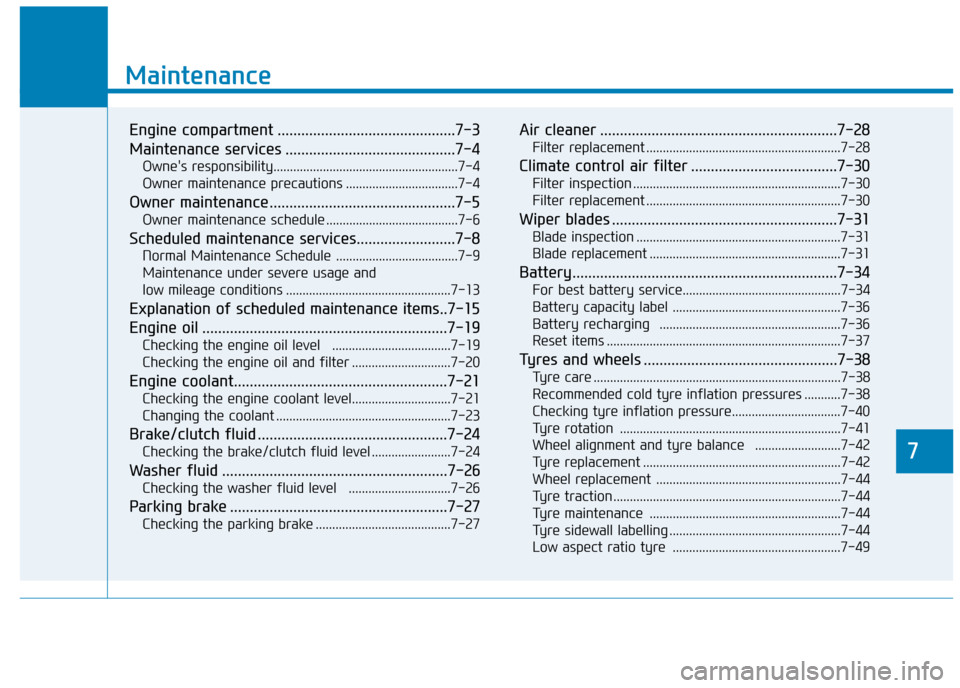
7
Maintenance
7
Maintenance
Engine compartment .............................................7-3
Maintenance services ...........................................7-4
Owne's responsibility........................................................7-4
Owner maintenance precautions ..................................7-4
Owner maintenance ...............................................7-5
Owner maintenance schedule ........................................7-6
Scheduled maintenance services.........................7-8
Normal Maintenance Schedule .....................................7-9
Maintenance under severe usage and
low mileage conditions ..................................................7-13
Explanation of scheduled maintenance items..7-15
Engine oil ..............................................................7-19
Checking the engine oil level ....................................7-19
Checking the engine oil and filter ..............................7-20
Engine coolant......................................................7-21
Checking the engine coolant level..............................7-21
Changing the coolant .....................................................7-23
Brake/clutch fluid ................................................7-24
Checking the brake/clutch fluid level ........................7-24
Washer fluid .........................................................7-26
Checking the washer fluid level ...............................7-26
Parking brake .......................................................7-27
Checking the parking brake .........................................7-27
Air cleaner ............................................................7-28
Filter replacement ...........................................................7-28
Climate control air filter .....................................7-30
Filter inspection ...............................................................7-30
Filter replacement ...........................................................7-30
Wiper blades .........................................................7-31
Blade inspection ..............................................................7-31
Blade replacement ..........................................................7-31
Battery...................................................................7-34
For best battery service................................................7-34
Battery capacity label ...................................................7-36
Battery recharging .......................................................7-36
Reset items .......................................................................7-37
Ty r e s a n d w h e e l s . . . . . . . . . . . . . . . . . . . . . . . . . . . . . . . . . . . . . . . . . . . . . . . . . 7 - 3 8
Ty r e c a r e . . . . . . . . . . . . . . . . . . . . . . . . . . . . . . . . . . . . . . . . . . . . . . . . . . . . . . . . . . . . . . . . . . . . . . . . . . . 7 - 3 8
Recommended cold tyre inflation pressures ...........7-38
Checking tyre inflation pressure.................................7-40
Ty r e r o t a t i o n . . . . . . . . . . . . . . . . . . . . . . . . . . . . . . . . . . . . . . . . . . . . . . . . . . . . . . . . . . . . . . . . . . . 7 - 4 1
Wheel alignment and tyre balance ..........................7-42
Ty r e r e p l a c e m e n t . . . . . . . . . . . . . . . . . . . . . . . . . . . . . . . . . . . . . . . . . . . . . . . . . . . . . . . . . . . . 7 - 4 2
Wheel replacement ........................................................7-44
Ty r e t r a c t i o n . . . . . . . . . . . . . . . . . . . . . . . . . . . . . . . . . . . . . . . . . . . . . . . . . . . . . . . . . . . . . . . . . . . . . 7 - 4 4
Ty r e m a i n t e n a n c e . . . . . . . . . . . . . . . . . . . . . . . . . . . . . . . . . . . . . . . . . . . . . . . . . . . . . . . . . . 7 - 4 4
Ty r e s i d e w a l l l a b e l l i n g . . . . . . . . . . . . . . . . . . . . . . . . . . . . . . . . . . . . . . . . . . . . . . . . . . . . 7 - 4 4
Low aspect ratio tyre ...................................................7-49
7
Page 473 of 571
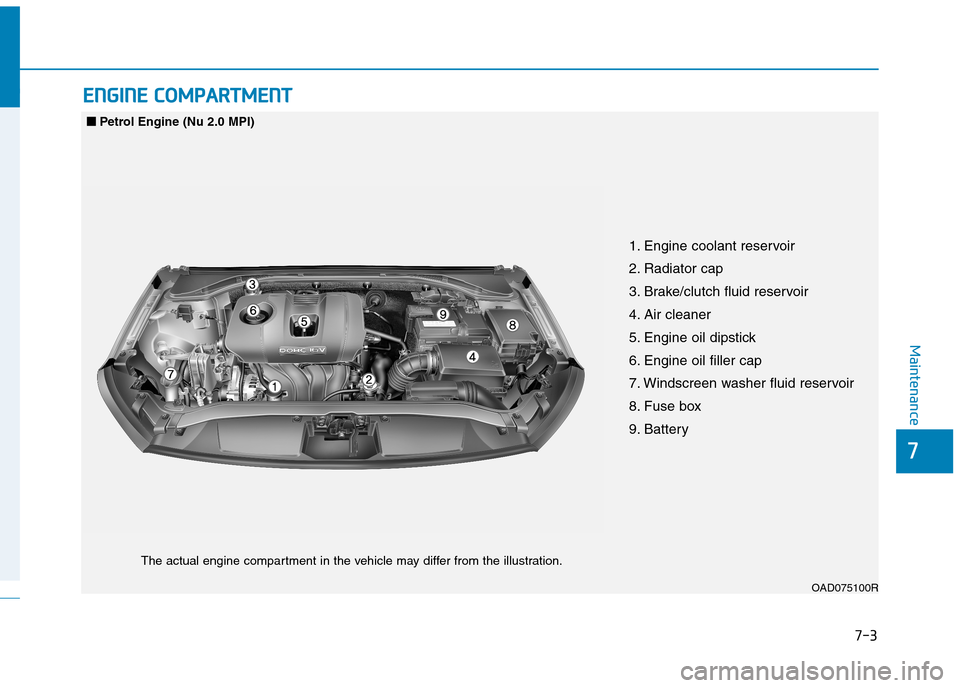
7-3
7
Maintenance
EENNGGIINNEE CCOOMMPPAARRTTMMEENNTT
OAD075100R
■■Petrol Engine (Nu 2.0 MPI)
The actual engine compartment in the vehicle may differ from the illustration.
1. Engine coolant reservoir
2. Radiator cap
3. Brake/clutch fluid reservoir
4. Air cleaner
5. Engine oil dipstick
6. Engine oil filler cap
7. Windscreen washer fluid reservoir
8. Fuse box
9. Battery
Page 475 of 571
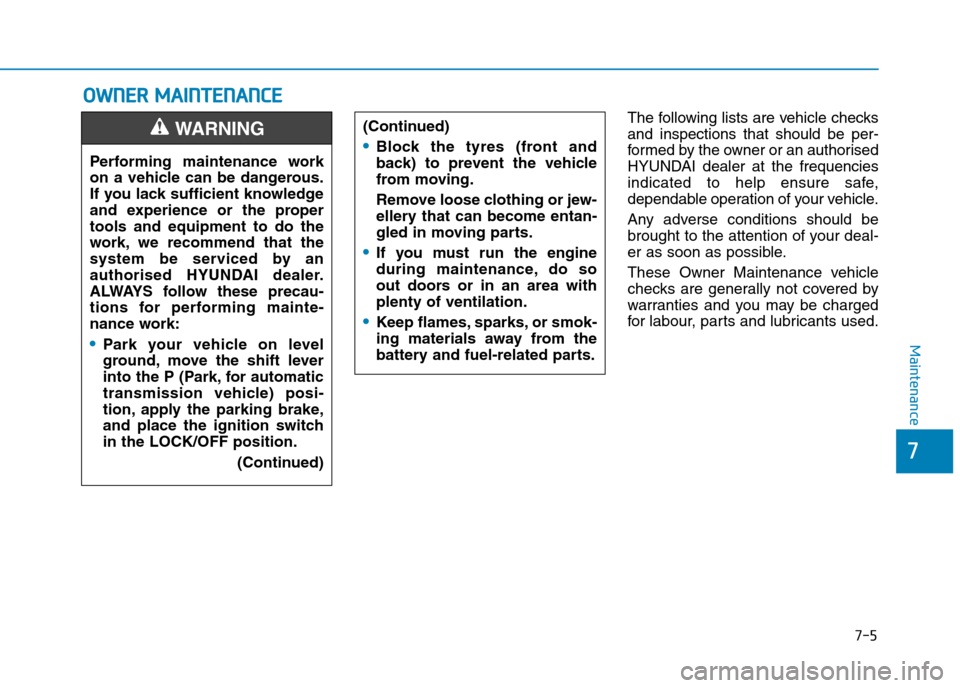
7-5
7
Maintenance
OOWWNNEERR MMAAIINNTTEENNAANNCCEE
The following lists are vehicle checks
and inspections that should be per-
for med by the owner or an authorised
HYUNDAI dealer at the frequencies
indicated to help ensure safe,
dependable operation of your vehicle.
Any adverse conditions should be
brought to the attention of your deal-
er as soon as possible.
These Owner Maintenance vehicle
checks are generally not covered by
warranties and you may be charged
for labour, par ts and lubricants used.
Performing maintenance work
on a vehicle can be dangerous.
If you lack sufficient knowledge
and experience or the proper
tools and equipment to do the
work, we recommend that the
system be serviced by an
authorised HYUNDAI dealer.
ALWAYS follow these precau-
tions for performing mainte-
nance work:
•Park your vehicle on level
ground, move the shift lever
into the P (Park, for automatic
transmission vehicle) posi-
tion, apply the parking brake,
and place the ignition switch
in the LOCK/OFF position.
(Continued)
WA R N I N G (Continued)
•Block the tyres (front and
back) to prevent the vehicle
from moving.
Remove loose clothing or jew-
ellery that can become entan-
gled in moving parts.
•If you must run the engine
during maintenance, do so
out doors or in an area with
plenty of ventilation.
•Keep flames, sparks, or smok-
ing materials away from the
battery and fuel-related parts.
Page 477 of 571
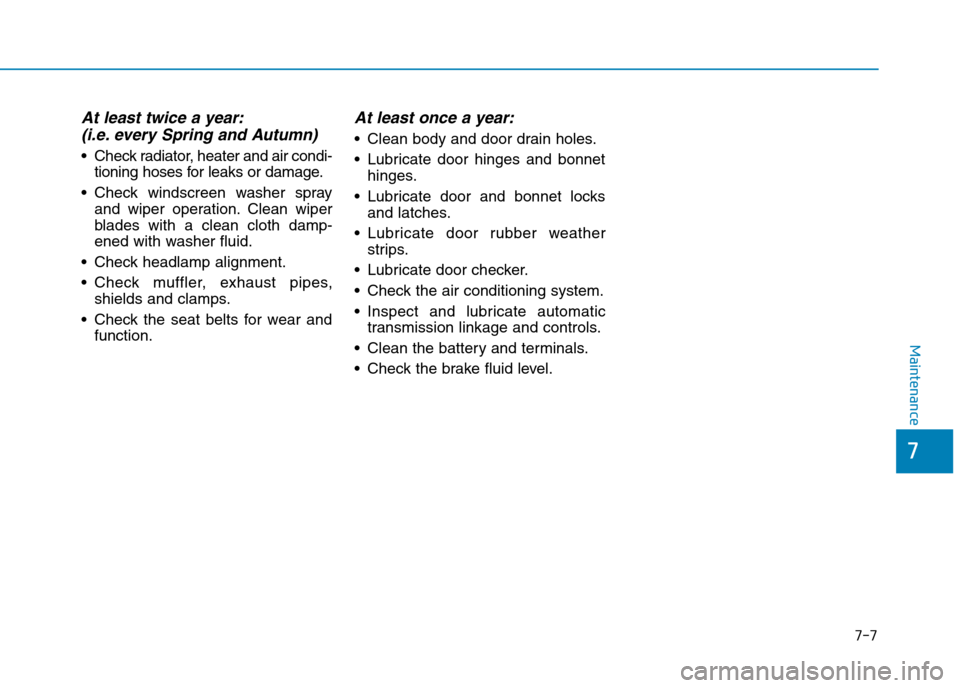
7-7
7
Maintenance
At least twice a year:
(i.e. every Spring and Autumn)
•Check radiator, heater and air condi-
tioning hoses for leaks or damage.
•Check windscreen washer spray
and wiper operation. Clean wiper
blades with a clean cloth damp-
ened with washer fluid.
•Check headlamp alignment.
•Check muffler, exhaust pipes,
shields and clamps.
•Check the seat belts for wear and
function.
At least once a year:
•Clean body and door drain holes.
•Lubricate door hinges and bonnet
hinges.
•Lubricate door and bonnet locks
and latches.
•Lubricate door rubber weather
strips.
•Lubricate door checker.
•Check the air conditioning system.
•Inspect and lubricate automatic
transmission linkage and controls.
•Clean the battery and terminals.
•Check the brake fluid level.
Page 481 of 571
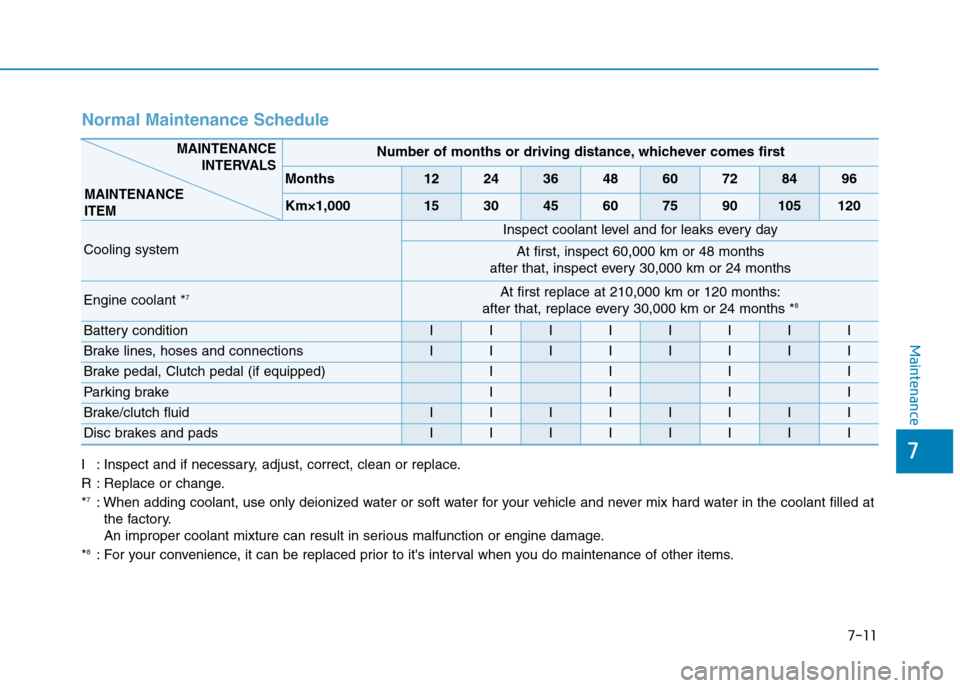
7-11
7
Maintenance
Normal Maintenance Schedule
I:Inspect and if necessary, adjust, correct, clean or replace.
R:Replace or change.
*7:When adding coolant, use only deionized water or soft water for your vehicle and never mix hard water in the coolant filled at
the factory.
An improper coolant mixture can result in serious malfunction or engine damage.
*8:For your convenience, it can be replaced prior to it's interval when you do maintenance of other items.
Number of months or driving distance, whichever comes first
Months1224364860728496
Km×1,000153045607590105120
Cooling system
Inspect coolant level and for leaks every day
At first, inspect 60,000 km or 48 months
after that, inspect every 30,000 km or 24 months
Engine coolant *7At first replace at 210,000 km or 120 months:
after that, replace every 30,000 km or 24 months *8
Battery conditionIIIIIIII
Brake lines, hoses and connectionsIIIIIIII
Brake pedal, Clutch pedal (if equipped)IIII
Par king brakeIIII
Brake/clutch fluidIIIIIIII
Disc brakes and padsIIIIIIII
MAINTENANCE
INTERVALS
MAINTENANCE
ITEM
Page 492 of 571
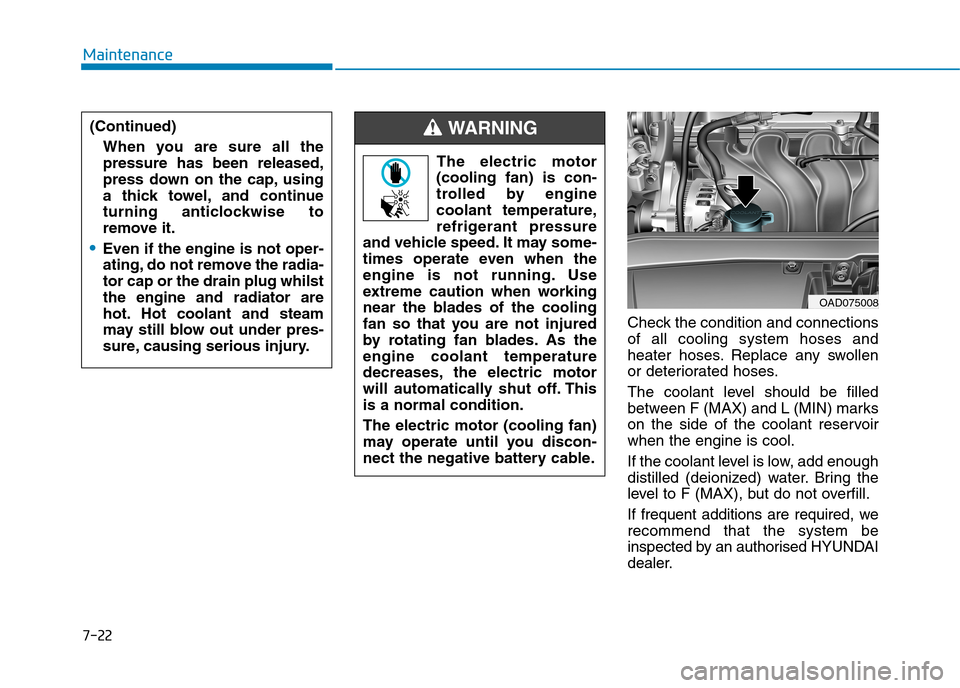
7-22
Maintenance
Check the condition and connections
of all cooling system hoses and
heater hoses. Replace any swollen
or deteriorated hoses.
The coolant level should be filled
between F (MAX) and L (MIN) marks
on the side of the coolant reservoir
when the engine is cool.
If the coolant level is low, add enough
distilled (deionized) water. Bring the
level to F (MAX), but do not overfill.
If frequent additions are required, we
recommend that the system be
inspected by an authorised HYUNDAI
dealer.
The electric motor
(cooling fan) is con-
trolled by engine
coolant temperature,
refrigerant pressure
and vehicle speed. It may some-
times operate even when the
engine is not running. Use
extreme caution when working
near the blades of the cooling
fan so that you are not injured
by rotating fan blades. As the
engine coolant temperature
decreases, the electric motor
will automatically shut off. This
is a normal condition.
The electric motor (cooling fan)
may operate until you discon-
nect the negative battery cable.
WA R N I N G
OAD075008
(Continued)
When you are sure all the
pressure has been released,
press down on the cap, using
a thick towel, and continue
turning anticlockwise to
remove it.
•Even if the engine is not oper-
ating, do not remove the radia-
tor cap or the drain plug whilst
the engine and radiator are
hot. Hot coolant and steam
may still blow out under pres-
sure, causing serious injury.
Page 504 of 571
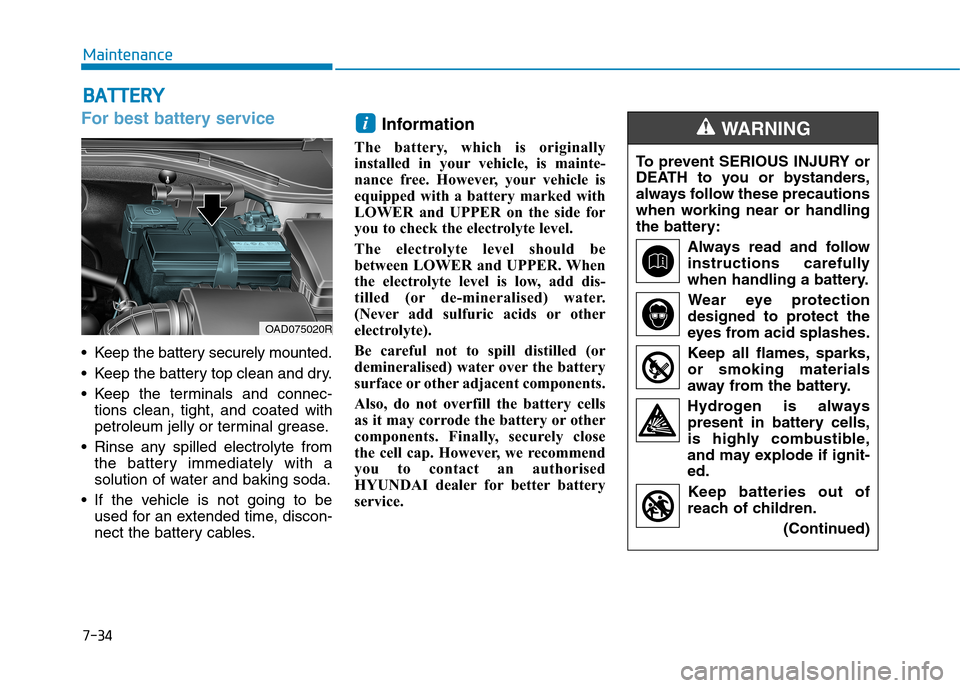
7-34
Maintenance
BBAATTTTEERRYY
For best battery service
•Keep the battery securely mounted.
•Keep the battery top clean and dry.
•Keep the terminals and connec-
tions clean, tight, and coated with
petroleum jelly or terminal grease.
•Rinse any spilled electrolyte from
the battery immediately with a
solution of water and baking soda.
•If the vehicle is not going to be
used for an extended time, discon-
nect the battery cables.
Information
The battery, which is originally
installed in your vehicle, is mainte-
nance free. However, your vehicle is
equipped with a battery marked with
LOWER and UPPER on the side for
you to check the electrolyte level.
The electrolyte level should be
between LOWER and UPPER. When
the electrolyte level is low, add dis-
tilled (or de-mineralised) water.
(Never add sulfuric acids or other
electrolyte).
Be careful not to spill distilled (or
demineralised) water over the battery
surface or other adjacent components.
Also, do not overfill the battery cells
as it may corrode the battery or other
components. Finally, securely close
the cell cap. However, we recommend
you to contact an authorised
HYUNDAI dealer for better battery
service.
i
OAD075020R
To p r e v e n t S E R I O U S I N J U RY o r
DEATH to you or bystanders,
always follow these precautions
when working near or handling
the battery:
Always read and follow
instructions carefully
when handling a battery.
Wear eye protection
designed to protect the
eyes from acid splashes.
Keep all flames, sparks,
or smoking materials
away from the battery.
Hydrogen is always
present in battery cells,
is highly combustible,
and may explode if ignit-
ed.
Keep batteries out of
reach of children.
(Continued)
WA R N I N G